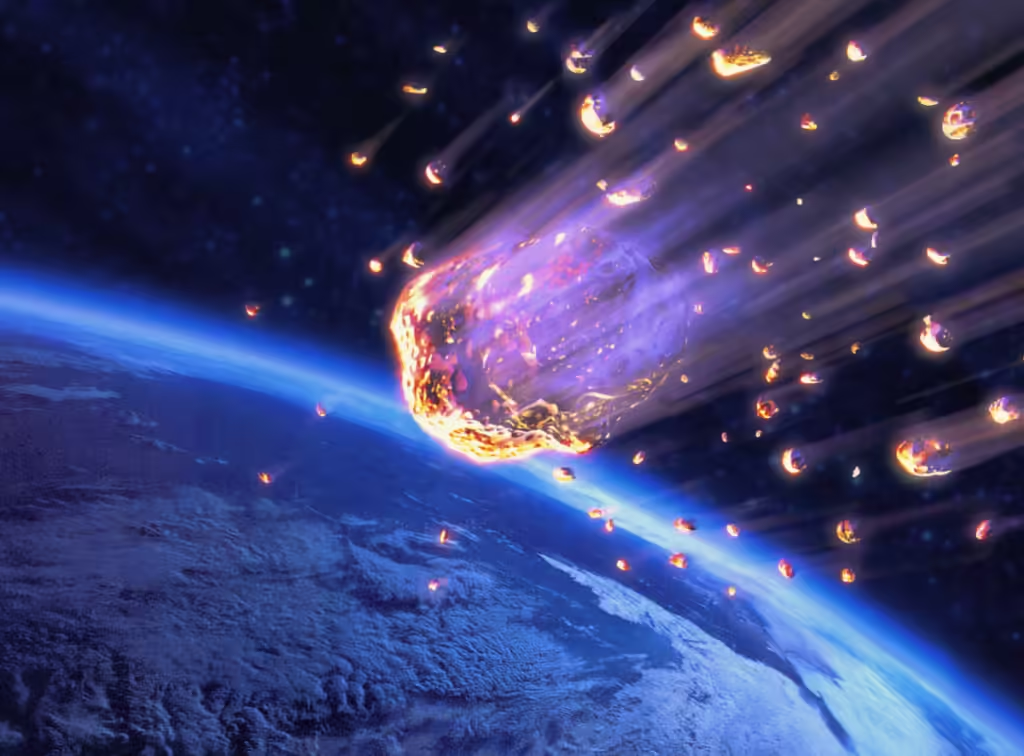


FAST DOWNLOAD
There was a time when Earth was an easy target. Meteorites repeatedly struck it, violently altering its surface: 3.26 billion years ago, a gigantic space rock larger than four Mount Everests — and up to 200 times larger than the one that wiped out the dinosaurs — crashed into our planet, leaving a mark so monumental that scientists can trace it to this day. But it failed to wipe out life, which was just beginning to awaken in the form of single-celled beings. On the contrary, it strengthened it, according to a new study.
The research, published Monday in the scientific journal PNAS, outlines some of the consequences that the meteorite — between 30 and 60 kilometers (18.6 to 37.3 miles) in diameter and dubbed S2 — had on planetary dynamics. The study’s lead author is Nadja Drabon, an early-Earth geologist at Harvard University, who followed the meteorite’s trail to the Barberton Greenstone Belt in South Africa. Drabon explains that “there are only a few places in the world where we have rocks that old. This is because plate tectonics constantly destroys the Earth’s crust. Barberton is one of those few places left, and the rocks are remarkably well-preserved.”
The first signs of the impact were found in the form of spherules the size of grains of sand. When such powerful strikes occur, meteorites and part of the Earth evaporate. This cloud of rock vapor circles the globe and forms these spherical particles. The researchers found a similar layer associated with the impact that wiped out the dinosaurs, but that layer is less than a centimeter thick, while the one in S2 is more than 15 centimeters.
The impact of the gigantic meteorite triggered a tsunami that stirred up the ocean and dragged debris from the seabed toward coastal areas. The heat of the impact caused the upper layer of the sea to evaporate and, consequently, the atmosphere warmed. A thick cloud of dust covered everything, darkening the planet and putting a halt to any photosynthetic activity that was taking place.
At first, the idea of such a powerful meteor impact and its effects might suggest that the entire Earth was wiped out and life was reduced to ashes. But in reality, it was a boost, says Drabon: “Until recently, impacts were thought to be disastrous for evolution. However, this way of thinking is changing and it is now believed that life was not only resilient, but may have benefited from such violent events.”
A fertilizer bomb
The researchers’ analysis reveals that bacterial life rebounded rapidly, leading to a sharp increase in populations of single-celled organisms. Even bacteria need food, and the meteorite cooked up a perfect recipe for them. The tsunami produced by the impact likely washed iron from the depths of the ocean into shallow waters, the article explains, and that both the space rock itself and increased soil erosion added phosphorus to the Earth’s surface.
Scientists have no doubt that the meteorite probably had an initial negative effect on any life forms living on land or in shallow water. But after that first blow, life quickly recovered. Drabon explains: “Before the impact, Earth’s early oceans were probably biological deserts due to a lack of nutrients and electron donors such as iron. The shock released essential nutrients on a global scale.”
In fact, one of the students who took part in the field research described the meteorite as “a fertilizer bomb.” What the study highlights, according to its lead author, is that this violence would have had benefits for life, which was in its infancy. “It allowed it to flourish,” says Drabon.

Juli Pereto, professor of biochemistry and molecular biology at the University of Valencia in Spain, points out that before the meteorite, ecosystems suffered from a shortage of these elements, which limited the expansion of life. “After the impact, a kind of global fertilisation took place, making these limiting chemical elements more accessible and giving a boost to the diversification and spread of microorganisms,” says the researcher, who was not involved in the study.
Like the Roman god Janus, S2 had two faces. On the one hand, it may have been catastrophic for part of the nascent biosphere: those organisms that could not withstand the temporary warming of the sea or the darkening of the atmosphere, which could have lasted for decades, perished. But it also represented an extraordinary evolutionary opportunity for microorganisms that until then had seen their expansion limited. “We can see it as further proof of life’s extraordinary capacity for adaptation,” Pereto sums up.
According to Jesús Martínez Frías, an expert in meteorites, planetary geology and astrobiology at the Spanish National Research Council, and president of the Spanish Network of Planetology and Astrobiology, this process is similar to what happens with large volcanic eruptions. “They have a destructive role, affecting environments and species, but also a constructive one because they reconstruct the marine and continental contexts that are affected by the catastrophe,” he points out.
The study opens a new line of research to unravel the mysteries of the early Earth. “We are exploring how other microbes reacted to the impact, for example those that metabolize sulfur,” explains Drabon. Her team is also analyzing environmental changes after other high-impact events in the early history of our planet, and how the first living beings took advantage of them.

